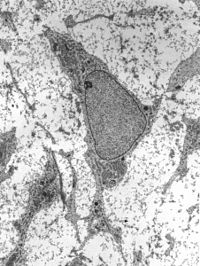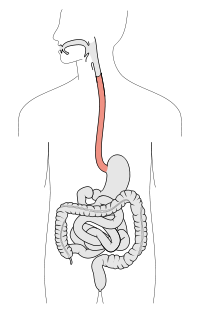
Overcoming the Blood-Brain Barrier: The Role of Nanomaterials in Treating Neurological Diseases.
Sign Up to like & getrecommendations! Published in 2018 at "Advanced materials"
DOI: 10.1002/adma.201801362
Abstract: Therapies directed toward the central nervous system remain difficult to translate into improved clinical outcomes. This is largely due to the blood-brain barrier (BBB), arguably the most tightly regulated interface in the human body, which… read more here.
Keywords: blood brain; brain; neurological diseases; brain barrier ... See more keywords

Inflammatory Cytokine Patterns Associated with Neurological Diseases in Coronavirus Disease 2019
Sign Up to like & getrecommendations! Published in 2021 at "Annals of Neurology"
DOI: 10.1002/ana.26041
Abstract: Patients with coronavirus disease 2019 (COVID‐19) can present with distinct neurological manifestations. This study shows that inflammatory neurological diseases were associated with increased levels of interleukin (IL)‐2, IL‐4, IL‐6, IL‐10, IL‐12, chemokine (C‐X‐C motif) ligand… read more here.
Keywords: cytokine patterns; patterns associated; disease 2019; inflammatory cytokine ... See more keywords

Targeting Inflammasomes to Treat Neurological Diseases
Sign Up to like & getrecommendations! Published in 2021 at "Annals of Neurology"
DOI: 10.1002/ana.26158
Abstract: Inflammasomes are multimeric protein complexes that can sense a plethora of microbe‐ and damage‐associated molecular signals. They play important roles in innate immunity and are key regulators of inflammation in health and disease. Inflammasome‐mediated processing… read more here.
Keywords: inflammasomes treat; inflammasome activation; disease; targeting inflammasomes ... See more keywords

Tubulin deacetylase NDST3 modulates lysosomal acidification: Implications in neurological diseases
Sign Up to like & getrecommendations! Published in 2022 at "BioEssays"
DOI: 10.1002/bies.202200110
Abstract: Neurological diseases (NDs), featured by progressive dysfunctions of the nervous system, have become a growing burden for the aging populations. N‐Deacetylase and N‐sulfotransferase 3 (NDST3) is known to catalyze deacetylation and N‐sulfation on disaccharide substrates.… read more here.
Keywords: neurological diseases; lysosomal acidification; deacetylase; tubulin deacetylase ... See more keywords

The neuroprotective effect and possible therapeutic application of xenon in neurological diseases.
Sign Up to like & getrecommendations! Published in 2021 at "Journal of neuroscience research"
DOI: 10.1002/jnr.24958
Abstract: Xenon is an inert gas with stable chemical properties which is used as an anesthetic. Recent in vitro and in vivo findings indicate that xenon also elicits an excellent neuroprotective effect in subanesthetic concentrations. The… read more here.
Keywords: neuroprotective effect; xenon; neurological diseases; possible therapeutic ... See more keywords

A concise review of the orofacial mesenchymal stromal cells as a novel therapy for neurological diseases and injuries
Sign Up to like & getrecommendations! Published in 2022 at "Journal of Tissue Engineering and Regenerative Medicine"
DOI: 10.1002/term.3333
Abstract: Orofacial mesenchymal stromal cells (OFMSCs) are mesenchymal stromal cells isolated from the oral and facial regions, which possess typical mesenchymal stromal cell features such as self‐renewing, multilineage differentiation, and immunoregulatory properties. Recently, increasing studies have… read more here.
Keywords: concise review; neurological diseases; mesenchymal stromal; orofacial mesenchymal ... See more keywords

Bridging the Metabolic Parallels Between Neurological Diseases and Cancer.
Sign Up to like & getrecommendations! Published in 2021 at "Advances in experimental medicine and biology"
DOI: 10.1007/978-3-030-65768-0_17
Abstract: Despite the many recent breakthroughs in cancer research, oncology has traditionally been seen as a distinct field from other diseases. Recently, more attention has been paid to repurposing established therapeutic strategies and targets of other… read more here.
Keywords: metabolic parallels; cancer neurological; metabolic overlap; bridging metabolic ... See more keywords

[Frequent neurological diseases associated with the restless legs syndrome].
Sign Up to like & getrecommendations! Published in 2018 at "Der Nervenarzt"
DOI: 10.1007/s00115-018-0528-y
Abstract: BACKGROUND Restless legs syndrome (RLS) is a common neurological disease. Studies have shown that RLS is associated with a variety of medical and neurological disorders. OBJECTIVES Using the example of three associated neurological diseases, the significance for… read more here.
Keywords: frequent neurological; prevalence; neurological diseases; legs syndrome ... See more keywords

[Antisense therapies for neurological diseases].
Sign Up to like & getrecommendations! Published in 2019 at "Der Nervenarzt"
DOI: 10.1007/s00115-019-0724-4
Abstract: Despite identification of many genes causing neurodegenerative diseases in the last decades, development of disease-modifying treatments has been slow. Antisense oligonucleotide (ASO) therapeutics for spinal muscular atrophy, Duchenne muscular dystrophy and transthyretin amyloidosis predict a robust… read more here.
Keywords: medicine; neurological diseases; antisense therapies; therapies neurological ... See more keywords

[Genomics and proteomics in the research of neuromuscular diseases].
Sign Up to like & getrecommendations! Published in 2021 at "Der Nervenarzt"
DOI: 10.1007/s00115-021-01201-1
Abstract: Neurological diseases affect 3-5% of children and, apart from cardiovascular diseases and cancer, represent the most prominent cause of morbidity and mortality in adults and particularly in the aged population of western Europe. Neuromuscular disorders… read more here.
Keywords: neuromuscular diseases; research neuromuscular; proteomics research; genomics proteomics ... See more keywords

Dysphagia in neurological diseases: a literature review
Sign Up to like & getrecommendations! Published in 2020 at "Neurological Sciences"
DOI: 10.1007/s10072-020-04495-2
Abstract: Dysphagia is defined as an impairment of this complex and integrated sensorimotor system. It is estimated that 400,000 to 800,000 individuals worldwide develop neurogenic dysphagia per year. Neurogenic dysphagia is typically occurring in patients with… read more here.
Keywords: dysphagia neurological; diseases literature; dysphagia; neurogenic dysphagia ... See more keywords